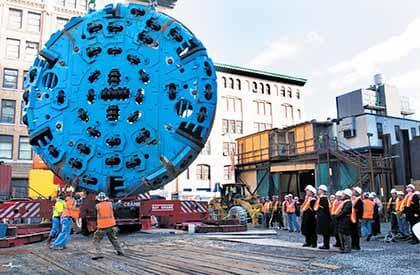By Philip Newman
A gigantic boring machine has finished a 7,612-foot tunnel to complete the first phase of the often-begun but yet-to-be-completed Second Avenue subway.
“Construction of this much-needed subway continues to move forward and this marks another major accomplishment to transform New York as we know it,” said MTA Capital Construction President Michael Horodniceanu. “These are tangible results that will not only expand our capacity but will also bring new economic activity and growth to Manhattan’s Upper East Side and points beyond.”
Phase 1 of the Second Avenue subway will serve more than 200,000 straphangers daily and relieve overcrowding on the Lexington Avenue line, which carries 40 percent of all subway patrons and is the only subway on Manhattan’s East Side. The project will ultimately enable LIRR commuters to travel to Grand Central as an alternative to Penn Station.
The new line will also restore a transportation link to a neighborhood that lost the Second Avenue elevated line when is was torn down in 1940.
U.S. Rep. Carolyn Maloney (D-Astoria), long one of the chief advocates of the Second Avenue project, hailed the news.
“We’re starting to see real progress now that the tunnel boring machine has completed the first tunnel,” Maloney said. “There’s still a lot of work to do, but that light at the end of the tunnel is growing ever-brighter now that this milestone has been reached. I congratulate the MTA and the construction team.”
Transit officials said that completion of Phase 1 will decrease crowding on the Lexington subway line by as much as 13 percent, or 23,000 fewer riders on an average weekday. It will also cut travel time by up to 10 minutes or more — up to 27 percent — for riders from the far East Side or those traveling from the East Side to west midtown.
Phase 1 of the Second Avenue subway will provide service from 63rd Street to 96th Street as an extension of the Q train, with the addition of three new ADA-accessible stations along Second Avenue at 72nd, 86th and 96th streets and new entrances to the existing Lexington Avenue-63rd Street station at 63rd Street and Third Avenue.
Forthcoming phases of the line will extend the new subway from 125th Street in Harlem to Hanover Square in the Financial District.
The new line will be built in a way to make possible extensions into Queens, Brooklyn and the Bronx.
TheMetropolitan Transportation Authority is also extending the No. 7 subway to Manhattan’s far West Side and building the Fulton Street Transit Center in lower Manhattan.
The East Side Access is estimated to cost $7.328 billion with completion in 2016. It will bring the Long Island Rail Road into a station 100 feet below Grand Central Terminal in a saving of time for tens of thousands of commuters who now arrive at Penn Station and switch to buses or other subway lines en route to work on the East Side.
The Second Avenue subway project, costing an estimated $4.451 billion with completion in 2016, goes back to the late 1920s and several stations were built in the early 1970s before work was halted when the city nearly went broke.
Reach contributing writer Philip Newman by e-mail at timesledgernews@cnglocal.com or phone at 718-260-4536.

































